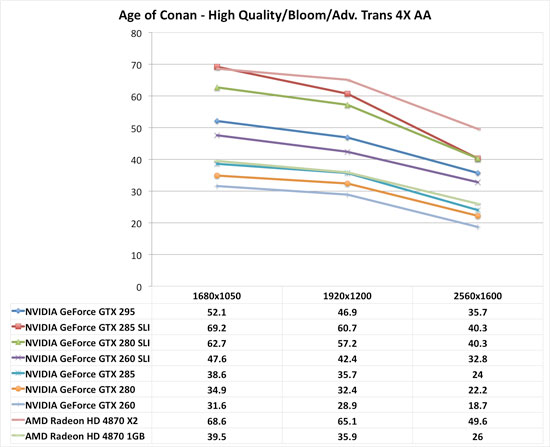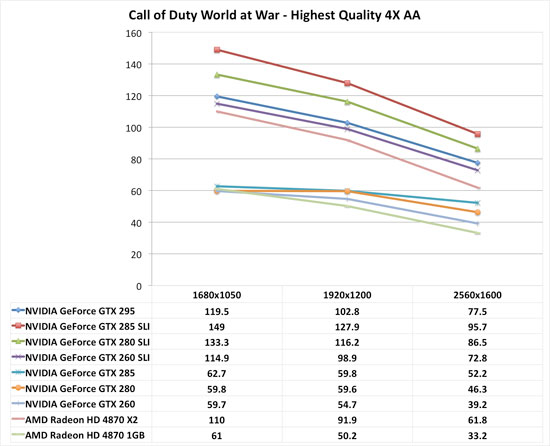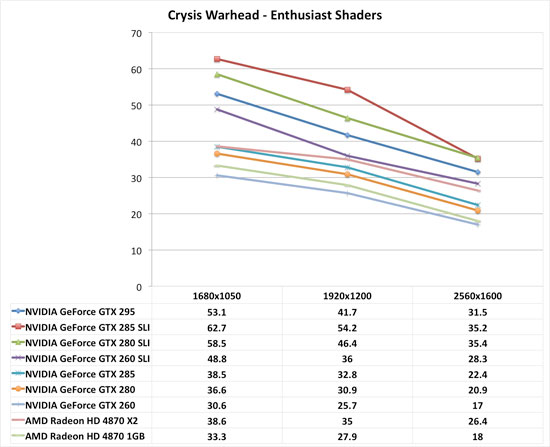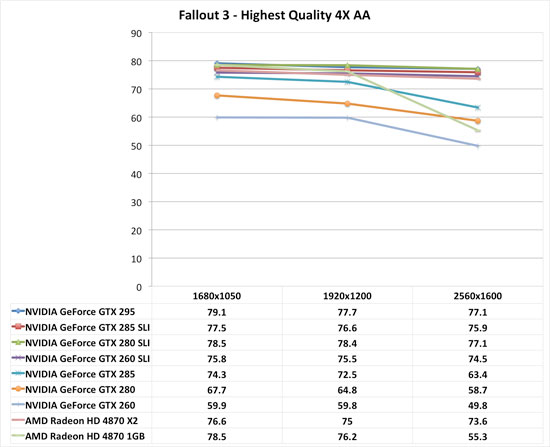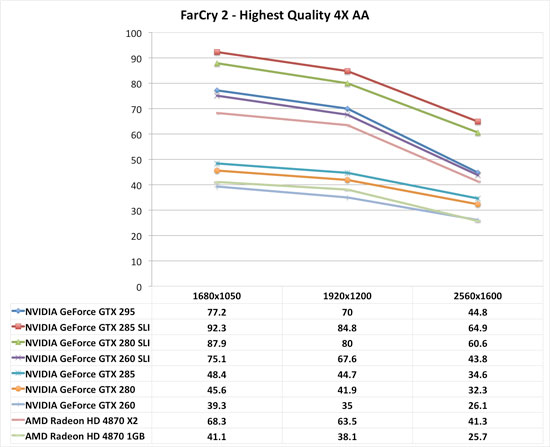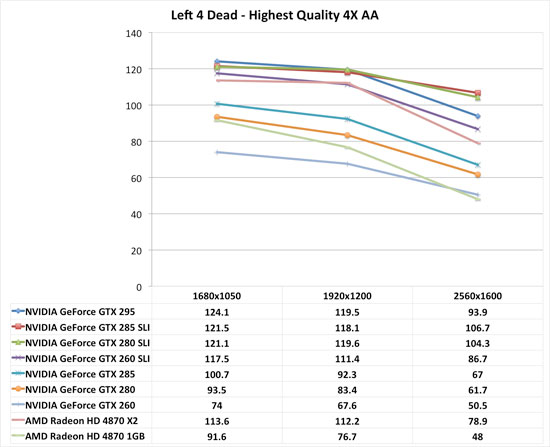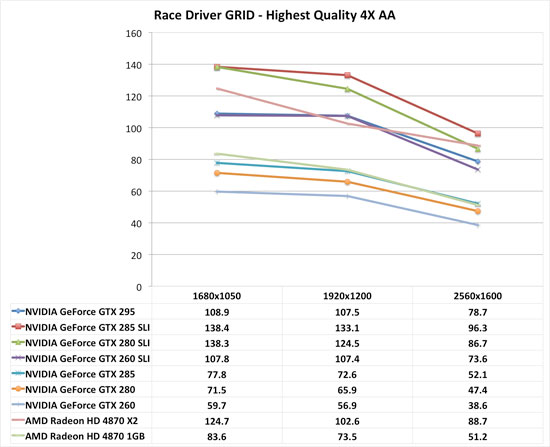
Original Link: https://www.anandtech.com/show/2711
GeForce GTX 285: 55nm Enabling Higher Performance
by Derek Wilson on January 15, 2009 9:00 AM EST- Posted in
- GPUs
Just last week, NVIDIA announced both the GTX 295 and GTX 285. Today we have availability on both and test results for the GTX 285. As we weren't able to get power tests done time to include in the GTX 295 review, we also have those available today.
EVGA was kind enough to provide the hardware for this review. They sent us two GTX 280s for single and SLI testing. They provided us with overclocked cards, but for this article we underclocked them to stock GTX 285 speeds in order to learn what we can expect from non-overclocked variants.

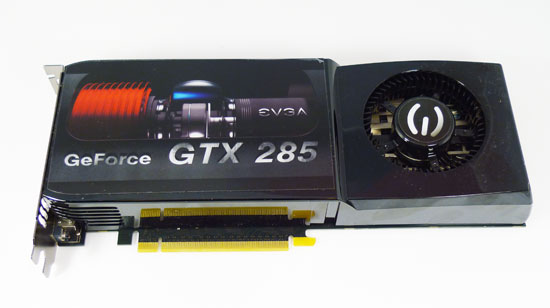
The hardware looks the same as the current GeForce GTX 280. There really isn't anything aside from the GPU that appears different (except the sticker on the card that is).
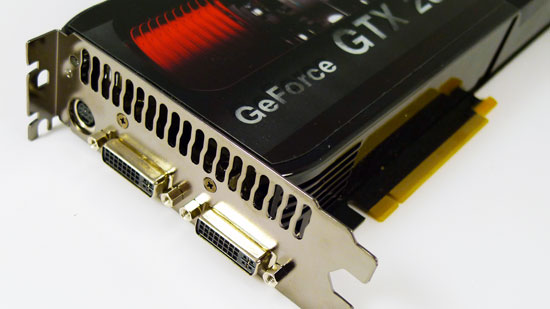
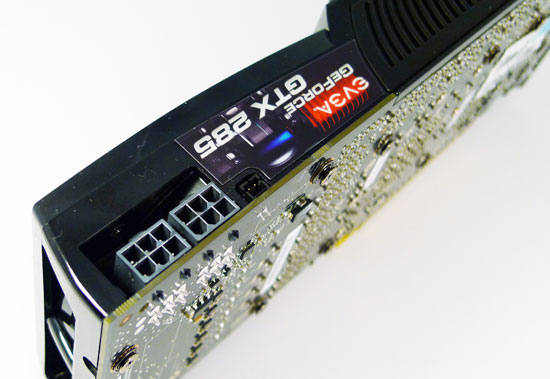
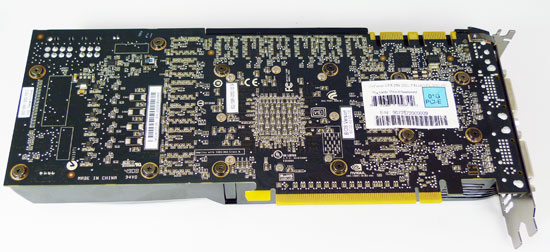
We've already indicated the changes that have gone into the GTX 285, but here's another look at the updated clock speeds and the test setup.
| GTX 295 | GTX 285 | GTX 280 | GTX 260 Core 216 | GTX 260 | 9800 GTX+ | |
| Stream Processors | 2 x 240 | 240 | 240 | 216 | 192 | 128 |
| Texture Address / Filtering | 2 x 80 / 80 | 80 / 80 | 80 / 80 | 72/72 | 64 / 64 | 64 / 64 |
| ROPs | 28 | 32 | 32 | 28 | 28 | 16 |
| Core Clock | 576MHz | 648MHz | 602MHz | 576MHz | 576MHz | 738MHz |
| Shader Clock | 1242MHz | 1476MHz | 1296MHz | 1242MHz | 1242MHz | 1836MHz |
| Memory Clock | 999MHz | 1242MHz | 1107MHz | 999MHz | 999MHz | 1100MHz |
| Memory Bus Width | 2 x 448-bit | 512-bit | 512-bit | 448-bit | 448-bit | 256-bit |
| Frame Buffer | 2 x 896MB | 1GB | 1GB | 896MB | 896MB | 512MB |
| Transistor Count | 2 x 1.4B | 1.4B | 1.4B | 1.4B | 1.4B | 754M |
| Manufacturing Process | TSMC 55nm | TSMC 55nm | TSMC 65nm | TSMC 65nm | TSMC 65nm | TSMC 55nm |
| Price Point | $500 | $400 | $350 - $400 | $250 - $300 | $250 - $300 | $150 - 200 |
The price point for the GTX 285 is $400, but newegg has parts for $380 right now and overclocked variants for not too much more.
The Test
| Test Setup | |
| CPU | Intel Core i7-965 3.2GHz |
| Motherboard | ASUS Rampage II Extreme X58 |
| Video Cards | ATI Radeon HD 4870 X2 ATI Radeon HD 4870 1GB NVIDIA GeForce GTX 295 EVGA NVIDIA GeForce GTX 285 SLI NVIDIA GeForce GTX 280 SLI NVIDIA GeForce GTX 260 SLI EVGA NVIDIA GeForce GTX 285 NVIDIA GeForce GTX 280 NVIDIA GeForce GTX 260 |
| Video Drivers | Catalyst 8.12 hotfix ForceWare 181.20 |
| Hard Drive | Intel X25-M 80GB SSD |
| RAM | 6 x 1GB DDR3-1066 7-7-7-20 |
| Operating System | Windows Vista Ultimate 64-bit SP1 |
| PSU | PC Power & Cooling Turbo Cool 1200W |
Age of Conan Performance
Age of Conan is our only MMO test both because it is very easy to benchmark and because it is graphically intensive as far as modern MMOs go even without DX10. The opening section of the game is restricted to just the player, so we are able to benchmark without the interference of other gamers. This also happens to be one of two test we are running that favor AMD hardware (the other test is Race Driver GRID).
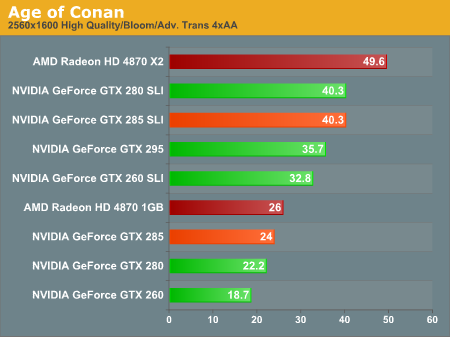
At 2560x1600, the GeForce GTX 285 splits the difference between the stock clocked GTX 280 and the Radeon HD 4870 1GB. At this res, SLI and CrossFire offer more robust and reliable performance than single cards, but 30 fps isn't necessarily required for a good experience with this MMO as long as framerates are smooth (which they are with the GTX 285 and the Radeon HD 4870 1GB).
Looking at the rest of the tests, we can see that the ~$380 GeForce GTX 285 is on par with the 4870 1GB (which can be had for about $250). Price wise, the competition with the GTX 285 is closer the more expensive Radeon HD 4870 X2 (which can be had for about $430 though some mail in rebate offers can net a better deal). The single card CrossFire solution provides much higher performance than the GTX 285 for the extra cash here.
As for the performance improvement over the stock clocked GTX 280 ranges from about 8% to a little over 10%, which is actually pretty good for the overclock we've got.
Call of Duty: World at War Performance
Call of Duty 5 is pretty good looking, though we much prefer the previous title in the series as far as the gaming experience goes. This newly added test at AnandTech seems to favor NVIDIA hardware. We test a section near the beginning of the game with a straight line FRAPS run through in the woods.
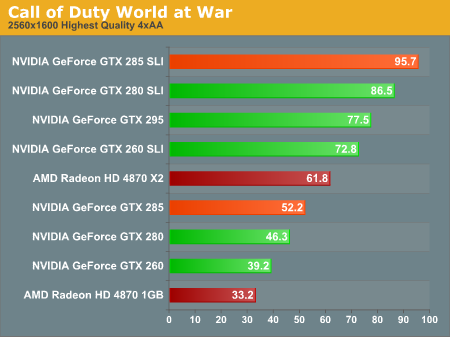
We see the GeForce GTX 285 come out way ahead of the Radeon 4870 1GB, but the 4870 X2 does best our newly released part by about 18% which is better than the 13% price premium paid for the fastest AMD single card over the GTX 285. As for the improvement the overclocked GTX 285 brings, it's more than 12% at 2560x1600 which is pretty good.
Looking at the rest of the tests show a bit of a performance barrier near 60 FPS despite the fact that we set max fps to 1000 and disabled vsync everywhere we could. Framerates under 2560x1600 are fairly compressed with a little separation at 1920x1200 that still shows the NVIDIA advantage, but not as clearly.
Crysis Warhead Performance
Crysis Warhead delivers improved performance over the original, but it is still a system killer. We are testing the frost level.
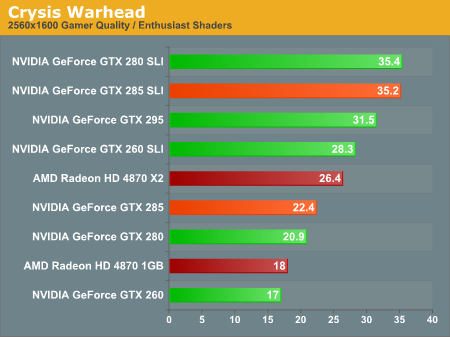
While the performance advantage of the Radeon HD 4870 X2 over the GTX 285 still leads the cost premium, neither of those two options really delivers playable framerates at this resolution. For 2560x1600 we really need the GTX 295 at a minimum.
The advantage of the GTX 285 over the GTX 280 ranges from about 5% to over 11.4% which still shows a good improvement. The performance lead the 4870 X2 maintained at 2560x1600 shrinks as resolution decreases, making the GTX 285 a better deal at playable resolutions.
Fallout 3 Performance
Fallout 3 is our replacement for Oblivion, but we see a lot more data compression here. Despite the fact that framerates were perfectly capable of rising beyond even 120 frames per second, our test seems fairly system limited at under 80 frames per second. We'll do what we can in the meantime but we will be looking for a better test going forward.
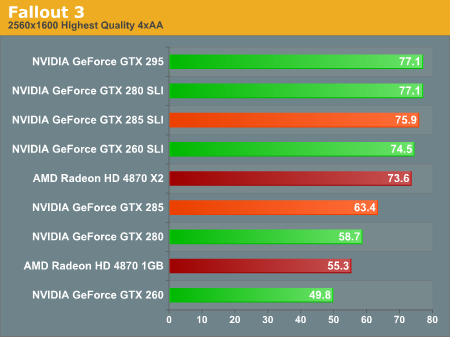
Despite the limitations, at 2560x1600 we do see some separation in the single card arena. The GTX 285 does pull ahead of the original GTX 280 and the Radeon HD 4870 1GB. The Radeon HD 4870 X2 does still lead the GTX 285 though. And there is just nothing we can determine about the SLI and CrossFire solutions with this data. But here are the rest of the numbers for those who want them.
FarCry 2 Performance
FarCry 2 can lean AMD and NVIDIA depending on the area of the game tested. We tried to go with a fairly balanced test.
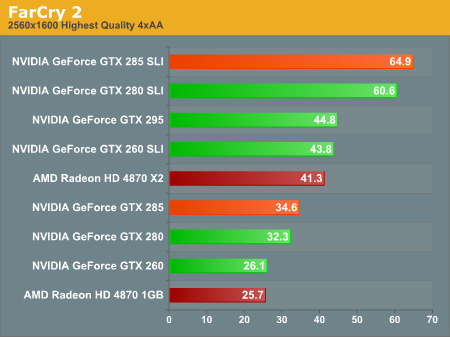
The GTX 285 can must a 10% performance improvement here, and it does still trail the 4870 X2 which has (again) over an 18% performance advantage for the slightly greater than 13% increased cost.
There are three performance teirs here. We've got the single GPU solutions in the bottom teir, the two single card dual-GPU offering bunched up with GTX 260 SLI in the middle and GTX 280 and 285 SLI taking the lead. The GeForce GTX 285 holds it's own against all the other single GPU setups.
Left 4 Dead Performance
The recent Left 4 Dead patch breaks demo playback, so it looks like we may be changing our test soon (though we do still have an unpatched copy we can use if we need to). This is just as well, as at the very high end we see a little system limitation.
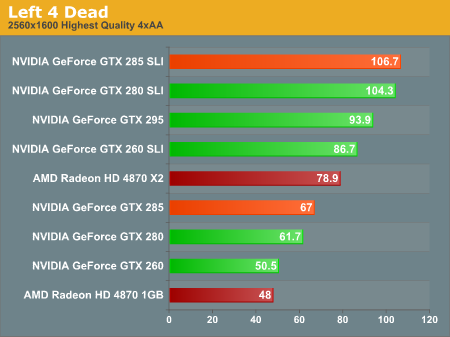
We've got an 8.5% improvement when moving from the GTX 280 to 285 here, which is about as good as it gets on Left 4 Dead. The 4870 X2 does still have a good advantage over the GTX 285 as well.
Race Driver GRID Performance
Out of our 7 tests, this is one of the two that favor AMD hardware. Alphabetical order puts the two AMD favoring tests first and last in our performance results.
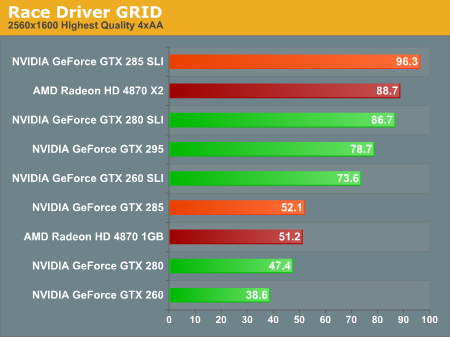
Again we see about a 10% improvement beyond the GeForce GTX 280 when moving to the GTX 285. This time the GTX 285 leads the 4870 1GB but only be a very little bit. The 4870 X2 trails only GTX 285 SLI at 2560x1600, which is way up there in framerate.
Smaller Die + More Performance = More Power
Power isn't going to be straight forward here, as this is both a die shrink and an overclock. If all other things were equal, the die shrink would have enabled a some power savings, but increasing the clock speeds (and likely voltages) means that we have factors at work that will push against each other. As for which will win, let's take a look at the data and find out.
Since we didn't take a look at power in our GeForce GTX 295 article, we'll keep an eye on that card as well. Also, keep in mind that there have been 55nm GTX 260s being slowly phased in but that our GTX 260 parts are 65nm. The 55nm GTX 260s will show a power advantage over similarly clocked 65nm GTX 260s.
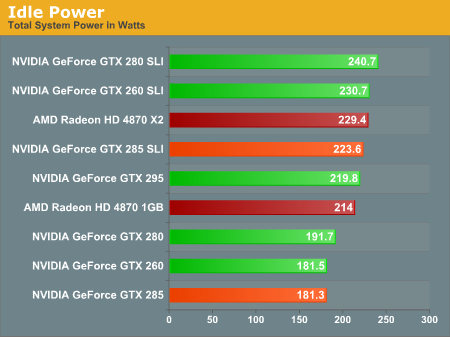
Idle power shows that NVIDIA is able to get some power savings when nothing is going on with the GPU. Power draw at idle decreased by about 10W with the move to 55nm which shows that in addition to their power saving features the die shrink does help. This advantage carries over to SLI as well with the GTX 285 SLI landing between the two single card dual-GPU systems.
The GeForce GTX 295 slides in just above the single GPU 4870 1GB while AMD's 4870 X2 consumes about 10W more than NVIDIA's higher performing dual-GPU card.
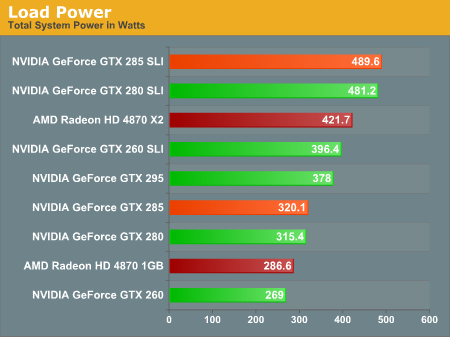
We see a different story when we look at load power. In spite of the die shrink, the added overclock pushes the GeForce GTX 285 higher under load than any other single GPU part. When SLI is enabled this becomes the most power hungry dual card setup we tested.
As for the GeForce GTX 295, we once again see good performance with lower power draw than the Radeon HD 4870 X2 and, in fact, less power draw than all the other dual-GPU setups we tested.
While a half node die shrink isn't the holy grail of power savings, the major advantage for NVIDIA comes from the die size decrease. We don't have measurements on the GPU after the shrink (we don't want to tear apart our hardware until we've tested things like 3-way SLI), but with the massive size of GT200 and the heavy price cuts NVIDIA was forced to make shortly after launch, the cost savings is a very important factor in this move.
NVIDIA needs to keep its price competitive and that means it needs to keep its costs down. Building an overclocked GTX 280 helps raise the price while building the parts at 55nm helps lower the cost. NVIDIA wants this card to be successful.
Final Words
So here's the deal. We can find the GTX 280 for about $340 if we aren't looking very hard (it can actually be had right now before mail in rebate for $325 at newegg but we'll give the 285 the benefit of the doubt). Compared to the $380 we can grab the new GeForce GTX 285 for, that's over 11% more money for only about 10% performance improvement. Of course there are more aggressively overclocked parts out there but they tend to cost a bit more as well. We do often see decreasing value with increasing performance, but it's not something we like. And if you don't mind mail in rebates the GTX 280 can be had for $300.
It looks like the benefit to the consumer here is going to be the unloading of GTX 280 hardware at prices that put it in better competition to the Radeon 4870 1GB. Of course the 4870 1GB is still a lot cheaper, but the GTX 280 starts to get a little more attractive at only 20% more expensive than the 4870 1GB as much of the time the performance advantage is larger than that. There are exceptions, of course.
It is a little more difficult to compare the GeForce GTX 285 to AMD hardware because of the price point. AMD doesn't have a card that hits the $400 mark (without mail in rebates that is: the 4870 X2 can hit $400 after mail ins). At about $50 more expensive, as we've noted, the 4870 X2 is just over 13% higher in price. Typically the 4870 X2, even in games that don't favor AMD architecture, leads the GeForce GTX 285 by more than that, often at performance about 18% higher at 2560x1600. This indicates that even at the higher price, value (price/performance) is higher with the 4870 X2.
In spite of the potential advantages offered by the Radeon 4870 X2, we have qualms about recommending it based on our experiences since October with the introduction of Core i7 and X58 and the multitude of software titles that were released. Driver support just isn't what it needs to be to really get behind an AMD single card dual-GPU solution right now. The issue is less about what's out now and more about support for titles as they come out and fast responses to issues (which AMD can't provide). The 8.12 hotfix (that is listed as only necessary with 4850 CrossFire) actually has improved stability and performance on all the single and dual setups we've tested on Core i7. We haven't finished putting it through its paces, but so far this one is a real step in the right direction. Unfortunately it will be months before we see this hotfix rolled into a WHQL driver. We definitely recommend this hotfix at least to anyone using AMD hardware on Vista x64 with a Core i7 platform.
In summary, despite its typical 10% performance advantage, the GeForce GTX 285 offers less price/performance than the GTX 280. The closest price competitor to the GTX 285, the Radeon HD 4870 X2, also offers better value, but at a higher price. At the same time, we have reservations about putting our weight behind the 4870 X2 with the driver issues we've experienced lately.

